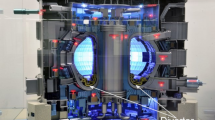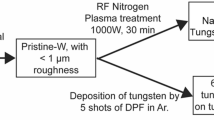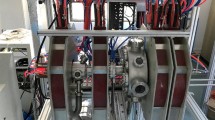Abstract
The tungsten (W) material as the divertor of fusion reactors is exposed to low-energy and high-flux He/H isotope irradiation, leading to the growth of fuzz layers. The W fuzz growth does not show any dependence on the plasma irradiation devices used; however, it is strongly dependent on He+ fluence and energy, irradiation temperature, and impurity level. When the incident He ions collide inside the dense fuzz layers with the extremely high specific area, their mean free path can be up to 690 nm. Up to now, the He bubble-driven W fuzz growth process is not entirely understood; however, it can be closely related to the surface bursting of He bubbles in the W surface layer and W surface erosion by He+ implantation. The formation of He bubbles can be attributed to the solute He diffusion into defects or bubbles, which is strongly affected by the temperature and He+ fluence. The W fuzz grows over the W surface, where the micro-stress caused by He bubbles in the W surface layer acts as the driving force. The W fuzz layer inhibits He+ implantation into W bulk, and provides an entire protection against the He+ erosion into W bulk beneath the fuzz layer. In this review article, the current status of experiment and theory are presented, and some of the remaining issues are discussed.


Reproduced with permission from Ref. [10]. Copyright 2020, International Atomic Energy Agency (IAEA)


Reproduced with permission from Ref. [10]. Copyright 2020, IAEA

Reproduced with permission from Ref. [12]. Copyright 2020, Elsevier

Reproduced with permission from Ref. [20]. Copyright 2013, Elsevier

Reproduced with permission from Ref. [24]. Copyright 2013, Elsevier

Reproduced with permission from Ref. [42]. Copyright 2020, Institute of Physics (IOP)

Reproduced with permission from Ref. [43]. Copyright 2021, Elsevier

Reproduced with permission from Ref. [44]. Copyright 2020, IAEA

Reproduced with permission from Ref. [51]. Copyright 2018, IAEA
Similar content being viewed by others
References
Temmerman GD, Hirai T, Pitts RA. The influence of plasma-surface interaction on the performance of tungsten at the ITER divertor vertical targets. Plasma Phys Control Fusion. 2018;60(4):044018.
Wright GM, Brunner D, Baldwin MJ, Doerner RP, Labombard B, Lipschultz B, Terry JL, Whyte DG. Tungsten nano-tendril growth in the Alcator C-Mod divertor. Nucl Fusion. 2012;52(4):042003.
Luo GN, Lu G, Liu X. Preface to the special issue on plasma facing materials for fusion energy. Tungsten. 2019;1:121.
Ohno N, Nishijima D, Takamura S, Uesugi Y, Motoyama M, Hattori N, Arakawa H, Ezumi N, Krasheninnikov S, Pigarov A, Wenzel U. Static and dynamic behaviour of plasma detachment in the divertor simulator experiment NAGDIS-II. Nucl Fusion. 2001;41(8):1055.
Hijazi H, Meyer FW. A large-acceptance beam-deceleration module for retrofitting into ion-source beam lines. Rev Sci Instrum. 2013;84(3):033305.
Meyer FW, Bannister ME, Hale JW, Havener CC, Krause HF, Vane CR, Deng S, Draganić IN, Harris PR. Recent activities at the ORNL multicharged ion research facility (MIRF), Proceedings of ECRIS2010, Grenoble, France, 2012; mocobk04.
Petty T, Baldwin M, Hasan M, Doerner R, Bradley J. Tungsten ‘fuzz’ growth re-examined: the dependenceon ion fluence in non-erosive and erosive helium plasma. Nucl Fusion. 2015;55(9):093033.
Liu L, Liu D, Hong Y, Fan H, Ni W, Yang Q, Bi Z, Benstetter G, Li S. High-flux He+ irradiation effects on surface damages of tungsten under ITER relevant conditions. J Nucl Mater. 2016;471:1.
Wang K, Doerner RP, Baldwin MJ, Meyer FW, Bannister ME, Darba A, Stroud R, Parish CM. Morphologies of tungsten nanotendrils grown under helium exposure. Sci Rep. 2016;7:42315.
McCarthy P, Hwangbo D, Bilton M, Kajita S, Bradley JW. Enhanced fuzzy tungsten growth in the presence of tungsten deposition. Nucl Fusion. 2020;60(2):026012.
Baldwin MJ, Doerner RP. Formation of helium induced nanostructure ‘fuzz’ on various tungsten grades. J Nucl Mater. 2010;404(3):165.
Liu L, Zhang Y, Fan H, Liu D, Niu C, Cheng L, Ni W. The effect of W fuzz growth on D retention in polycrystalline W. J Nucl Mater. 2020;539:152327.
Nishijima D, Baldwin MJ, Doerner RP, Yu JH. Sputtering properties of tungsten ‘fuzzy’ surfaces. J Nucl Mater. 2011;415(1):S96.
Kajita S, Nojima T, Tomita Y, Ohno N, Tanaka H, Yoshida N, Yajima M, Akiyama T, Tokitani M, Yagi T. Fuzzy nanostructure growth on precious metals by He plasma irradiation. Surf Coat Tech. 2018;340:86.
Frauenfelder R. Solution and Diffusion of Hydrogen in Tungsten. J Vac Sci Tech. 1969;6(3):388.
You YW, Li D, Kong XS, Wu X, Liu CS, Fang QF, Pan BC, Chen JL, Luo GN. Clustering of H and He, and their effects on vacancy evolution in tungsten in a fusion environment. Nucl Fusion. 2014;54(10):103007.
Ogorodnikova OV, Roth J, Mayer M. Deuterium retention in tungsten in dependence of the surface conditions. J Nucl Mater. 2003;313–316:469.
Becquart CS, Domain C. Migration Energy of He in W Revisited by Ab Initio Calculations. Phys Rev Lett. 2006;97(19):196402.
Zhou HB, Liu YL, Jin S, Zhang Y, Luo GN, Lu GH. Towards suppressing H blistering by investigating the physical origin of the H-He interaction in W. Nucl Fusion. 2010;50(11):115010.
Shu X, Tao P, Li X, Yu Y. Helium diffusion in tungsten: A molecular dynamics study. Nucl Instrum Methods Phys Res B. 2013;303:84.
Henriksson KOE, Nordlund K, Keinonen J. Molecular dynamics simulations of helium cluster formation in tungsten. Nucl Instr Meth Phys Res B. 2006;244(2):377.
Kamada K. Hydrogen implantation effects in the subsurface layer of aluminum -bubble pressure and surface modifications. J Nucl Mater. 1989;169:141.
Greenwood GW, Foreman AJE, Rimmer DE. The role of vacancies and dislocations in the nucleation and growth of gas bubbles in irradiated fissile material. J Nucl Mater. 1959;1(4):305.
Sang C, Sun J, Bonnin X, Liu S, Wang D. Numerical simulation of the bubble growth due to hydrogen isotopes inventory processes in plasma-irradiated tungsten. J Nucl Mater. 2013;443(1–3):403.
Funabiki T, Shimada T, Ueda Y. Nishikawa M. Effect of tungsten microstructure on blister formation by hydrogen and carbon mixed ion beam irradiation. J Nucl Mater. 2004, 329–333:780.
Ueda Y, Funabiki T, Shimada T, Fukumoto K, Kurishita H, Nishikawa M. Hydrogen blister formation and cracking behavior for various tungsten materials. J Nucl Mater. 2005;337–339:1010.
Fukumoto M, Ohtsuka Y, Ueda Y, Taniguchi M, Kashiwagi M, Inoue T, Sakamoto K. Blister formation on tungsten damaged by high energy particle irradiation. J Nucl Mater. 2008;375:224.
Bi Z, Liu D, Zhang Y, Liu L, Xia Y, Hong Y, Fan H, Benstetter G, Lei G, Yan L. The evolution of He nanobubbles in tungsten under fusion-relevant He ion irradiation conditions. Nucl Fusion. 2019;59(8):086025.
Kajita S, Sakaguchi W, Ohno N, Yoshida N, Saeki T. Formation process of tungsten nanostructure by the exposure to helium plasma under fusion relevant plasma conditions. Nucl Fusion. 2009;49(9):095005.
Yang Q, You YW, Liu L, Fan HY, Ni WY, Liu DP, Liu CS, Benstetter G, Wang YN. Nanostructured fuzz growth on tungsten under low-energy and high-flux He irradiation. Sci Rep. 2015;5:10959.
Woller KB, Whyte DG, Wright GM, Doerner RP, Temmerman DG. Helium concentration in tungsten nano-tendril surface morphology using Elastic Recoil Detection. J Nucl Mater. 2013;438:S913.
Nguyen-Manh D, Horsfield AP, Dudarev SL. Self-interstitial atom defects in bcc transition metals: Group-specific trends. Phys Rev B. 2006;73:020101.
Park NY, Kim YC, Seok HK, Han SH, Cho S, Cha PR. Molecular dynamics simulation of irradiation damage in tungsten. Nucl Instrum Methods Phys Res B. 2007;265:547.
Derlet PM, Nguyen-Manh D, Dudarev SL. Multiscale modeling of crowdion and vacancy defects in body-centered-cubic transition metals. Phys Rev B. 2007;76:054107.
Zhou WH, Li YG, Huang LF, Zeng Z, Ju X. Dynamical behaviors of self-interstitial atoms in tungsten. J Nucl Mater. 2013;437:438.
Duan G, Li X, Sun J, Hao C, Xu Y, Zhang Y, Liu W, Liu CS. Surface-structure dependence of healing radiation-damage mechanism in nanoporous tungsten. J Nucl Mater. 2018;498:362.
Xu W, Adams JB. W single adatom diffusion on W surfaces. Surf Sci. 1994;319:58.
Antczak G, Ehrlich G. Jump processes in surface diffusion. Surf Sci Rep. 2007;62:39.
Antczak G. Long jumps in one-dimensional surface self-diffusion: Rebound transitions. Phys Rev B. 2006;73:033406.
Bannister ME, Meyer FW, Hijazi H, Unocic KA, Garrison LM, Parish CM. Surface morphologies of He-implanted tungsten. Nucl Instrum Methods Phys Res B. 2016;382:76.
Parish CM, Hijazi H, Meyer HM, Meyer FW. Effect of tungsten crystallographic orientation on He-ion-induced surface morphology changes. Acta Mater. 2014;62:173.
Patino MI, Nishijima D, Tokitani M, Nagata D, Doerner RP. Material mixing during fuzz formation in W and Mo. Phys Scr. 2020;T171:014070.
Niu C, Zhang Y, Cui Y, Li X, Liu W, Ni W, Fan H, Lu N, Benstetter G, Lei G, Liu D. Effect of temperature on the growth and surface bursting of He nano-bubbles in W under fusion-relevant He ion irradiations. Fusion Eng Des. 2021;163:112159.
Fan H, Zhang Y, Liu D, Niu C, Liu L, Ni W, Xia Y, Bi Z, Hong Y, Benstetter G, Lei G. Tensile stress-driven cracking of W fuzz over W crystal under fusion relevant He ion irradiations. Nucl Fusion. 2020;60(4):046011.
Ni W, Zhang Y, Cui Y, Niu C, Liu L, Fan H, Benstetter G, Lei G, Liu D. The effect of fusion-relevant He ion flux on the evolution of He nano-bubbles in W Plasma Phys. Control Fusion. 2020;62(6):065002.
Baldwin MJ, Doerner RP, Nishijima D, Tokunaga K, Ueda Y. The effects of high fluence mixed-species (deuterium, helium, beryllium) plasma interactions with tungsten. J Nucl Mater. 2009;390–391:886.
Petty TJ, Baldwin MJ, Hasan MI, Doerner RP, Bradley JW. Tungsten “fuzz” growth re-examined: the dependence on ion fluence in non-erosive and erosive helium plasma. Nucl Fusion. 2015;55(9):093033.
Noiri Y, Kajita S, Ohno N. Nanostructure growth by helium plasma irradiation to tungsten in sputtering regime. J Nucl Mater. 2015;463:285.
Liu L, Li S, Liu D, Benstetter G, Man O, Michalicka J, Zhang Y, Hong Y, Fan H, Ni W, Yang Q, Wu Y, Bi Z. The effect of O2 impurity on surface morphology of polycrystalline W during low-energy and high-flux He+ irradiation. Fusion Eng Des. 2019;139:96.
Ni W, Zhang Y, Niu C, Cui Y, Liu W, Li X, Fan H, Song G, Liu D. The effect of Ar+ impurity on W nano-fuzz growth over polycrystalline W targets. J Nucl Mater. 2020;536:152229.
Hwangbo D, Kajita S, Ohno N, McCarthy P, Bradley JW, Tanaka H. Growth of nano-tendril bundles on tungsten with impurity-rich He plasmas. Nucl Fusion. 2018;58(9):096022.
Valles G, Martin-Bragado I, Nordlund K, Lasa A, Björkas C, Safi E, Perlado JM, Rivera A. Temperature dependence of underdense nanostructure formation in tungsten under helium irradiation. J Nucl Mater. 2017;490:108.
Sakamoto R, Bernard E, Kreter A, Yoshida N. Surface morphology of tungsten exposed to helium plasma at temperatures below fuzz formation threshold 1073 K. Nucl Fusion. 2017;57(1):016040.
Meyer FW. He-ion induced surface morphology change and nanofuzz growth on hot tungsten surfaces*. J Phys B: At Mol Opt Phys. 2019;52(1):012001.
Acknowledgements
This work was financially supported by the National Key R&D Program of China (Grant No. 2017YFE0300106), the National Science Foundation of China (Grant No.11320101005), Liaoning Provincial Natural Science Foundation (Grant Nos. 20180510006 and 2019-ZD-0186), and Dalian Science and Technology Star Project (Grant No. 2017RQ149).
Author information
Authors and Affiliations
Contributions
Authors’ Contributions
Wei-Yuan Ni, Hong-Yu Fan and Dong-Pin Liu wrote the draft; Chun-Jie Niu and Yang Zhang collected the data; Yun-Qiu Cui and Lu Liu contributed to conceived the idea of the study. All authors contributed to the writing and revisions.
Corresponding authors
Ethics declarations
Conflict of Interest
The authors declare no conflict of interest.
Additional information
Publisher's Note
Springer Nature remains neutral with regard to jurisdictional claims in published maps and institutional affiliations.
Rights and permissions
About this article
Cite this article
Ni, WY., Fan, HY., Niu, CJ. et al. He bubble-driven growth of W fuzz during the interaction between H2/He plasmas and W materials. Tungsten 3, 393–405 (2021). https://doi.org/10.1007/s42864-021-00096-4
Received:
Revised:
Accepted:
Published:
Issue Date:
DOI: https://doi.org/10.1007/s42864-021-00096-4




